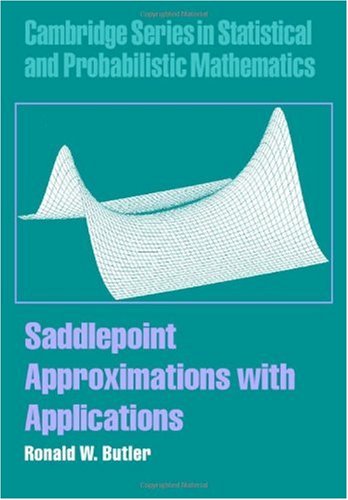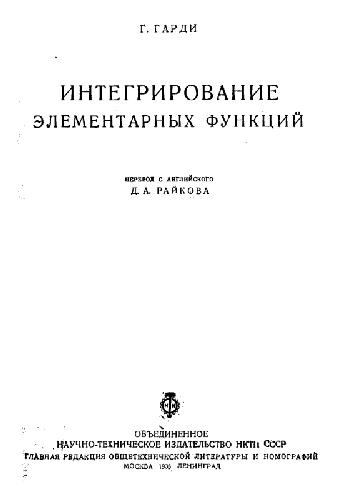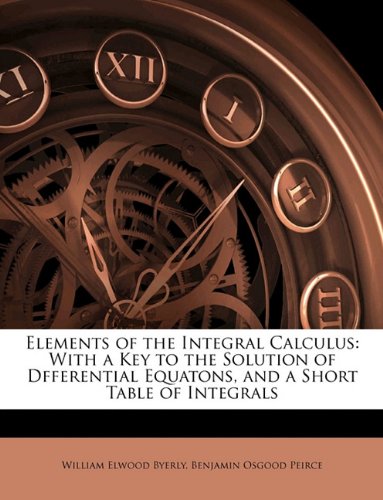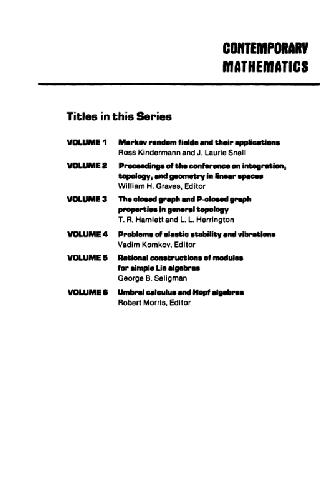Ronald W. Butler0521872502, 9780521872508, 9780511342394
Table of contents :
Half-title……Page 3
Series-title……Page 4
Title……Page 5
Copyright……Page 6
Contents……Page 7
Preface……Page 11
Acknowledgements……Page 12
1.1.1 Preliminaries……Page 15
1.1.2 Saddlepoint density functions……Page 17
1.1.3 Examples……Page 18
1.1.4 Remarks……Page 20
1.1.5 Saddlepoint mass functions……Page 22
1.1.6 Examples……Page 23
1.2.1 Continuous distributions……Page 26
1.2.2 Examples……Page 27
First continuity correction……Page 31
Third approximation……Page 32
1.2.4 Examples……Page 33
1.2.5 Alternative left-tail CDF approximations for discrete distributions……Page 37
Alternative left tail for the first continuity correction……Page 38
Examples……Page 39
1.2.6 Performance summary for continuity corrections……Page 40
Interconnections of………Page 41
1.3 Failure (hazard) rate approximation……Page 42
1.5 Computational notes……Page 44
1.6 Exercises……Page 45
2.1.1 Equivariance……Page 52
2.1.2 Symmetry……Page 53
2.2 Saddlepoint density……Page 55
2.2.1 Laplace’s approximation……Page 56
2.2.2 Derivation of the saddlepoint density……Page 61
2.3.1 Temme approximation……Page 63
2.3.2 Derivation of saddlepoint CDF……Page 65
2.4.1 Mellin transforms……Page 68
Accuracy……Page 71
2.4.2 Central limit connections……Page 74
2.4.4 Continuity-corrected approximations on a Delta-lattice……Page 76
2.4.5 A statistical interpretation of the saddlepoint CDF……Page 77
2.4.6 Normalization……Page 78
2.5.1 Asymptotic Laplace expansions……Page 80
2.5.2 The removable singularities in the Lugannani and Rice approximations……Page 82
2.6 Exercises……Page 84
3.1.1 Preliminaries……Page 89
Standard multivariate Normalm(0, I) density……Page 90
Multivariate gamma density……Page 91
Multinomial mass function……Page 94
Bivariate Poisson mass function……Page 95
3.2.1 Laplace’s approximation……Page 97
Properties of Laplace’s approximation……Page 99
3.2.2 Derivation of the saddlepoint density……Page 103
3.3.3 Marginalization……Page 105
3.3.4 Symmetry……Page 106
3.4.1 Bootstrap distribution of the sample mean……Page 107
3.4.2 Durbin–Watson statistic and the Dirichlet bootstrap……Page 108
3.4.3 Rotationally symmetric density……Page 109
3.4.4 High dimensional Laplace approximation……Page 111
3.4.5 High dimensional saddlepoint mass function……Page 114
3.5 Multivariate CDFs……Page 115
3.6 Exercises……Page 116
4.1 Conditional saddlepoint density and mass functions……Page 121
Binomial (Eta, Theta)……Page 123
Bivariate exponential……Page 124
4.1.3 Remarks on asymptotics……Page 125
4.2.1 Continuous distributions……Page 127
Second continuity correction……Page 128
Binomial (Eta, Theta)……Page 129
Pólya (M, N; n)……Page 132
4.2.4 Proof of the Skovgaard approximation……Page 133
Invariance……Page 134
4.2.6 Remarks on asymptotics……Page 136
4.3.1 Bootstrap distribution of the sample mean……Page 137
4.3.3 Bayesian posterior for the mean of an infinite population……Page 138
4.3.6 Permutation and Wilcoxon rank sum tests……Page 139
4.4.1 Central limit connections……Page 140
4.4.2 Saddlepoint geometry……Page 143
4.4.3 Normalizing double-saddlepoint densities……Page 144
4.4.4 Conditional single-saddlepoint approximations……Page 145
4.5.1 Symmetry of the Skovgaard approximation……Page 146
4.5.3 Differentiation of the Skovgaard approximation……Page 148
4.6 Exercises……Page 150
5.1.1 Definitions and examples……Page 159
5.1.2 Properties……Page 160
Product families……Page 161
Maximum likelihood estimation……Page 162
Fisher information……Page 163
Conditional families……Page 164
5.2.1 Tchebycheff–Hermite polynomials……Page 165
5.2.3 Edgeworth series……Page 166
5.3.1 Tilting and saddlepoint approximation……Page 170
5.3.2 Comments on tilting and saddlepoint accuracy……Page 171
5.4.1 Saddlepoint densities for canonical sufficient statistics……Page 172
5.4.2 Conditional saddlepoint densities for canonical sufficient statistics……Page 175
5.4.3 Saddlepoint CDF for a canonical sufficient statistic……Page 179
Distribution theory……Page 180
Marginal likelihood ratio test……Page 182
Likelihood ratio test……Page 183
5.4.5 Conditional saddlepoint CDF for a canonical sufficient statistic……Page 184
One parameter regular exponential families……Page 190
Multiparameter regular exponential families……Page 192
5.5 Exercises……Page 193
6.1.1 Example: Aphids……Page 197
6.1.2 Logistic regression and significance tests……Page 199
6.1.3 Confidence interval theory from p-value inversion……Page 201
6.1.4 Mid-p-values and their inversion……Page 202
p-values…….Page 203
6.1.5 LD50 confidence intervals……Page 204
6.1.6 Prospective and retrospective analyses……Page 205
6.2.1 With 1 : mi matching cases……Page 207
Power function……Page 209
Confidence interval for………Page 212
6.2.2 Single-saddlepoint power functions and confidence intervals……Page 213
6.2.3 With m1i : m2i matching cases……Page 214
Single-saddlepoint approach……Page 215
Double saddlepoint approach……Page 216
6.2.4 Double-saddlepoint power functions and confidence intervals……Page 220
6.2.5 Pascual sampling……Page 221
6.3 Times series analysis of truncated count data……Page 222
6.4 Exponential families of Markov processes……Page 223
6.4.2 Example: Nonhomogeneous Poisson process……Page 224
6.5 Truncation……Page 226
6.6 Exercises……Page 227
7.1 The p* density in regular exponential families……Page 233
Gamma (Alpha, Beta)……Page 234
Hyperbolic secant (HBS) distribution……Page 235
Planck’s radiation formula……Page 236
One parameter models……Page 237
Vector parameter, composite hypotheses, and more general models……Page 238
7.2.1 Location model……Page 239
Example: Exponential……Page 241
7.2.2 Location and scale model……Page 242
7.2.3 Linear model……Page 243
7.3.1 Curved exponential families……Page 244
Gamma hyperbola……Page 246
7.3.3 Affine ancillaries……Page 248
Gamma hyperbola……Page 250
7.3.4 p as a conditionality resolution with affine ancillaries……Page 252
Gamma hyperbola……Page 253
Bivariate normal correlation……Page 254
Gamma exponential……Page 255
7.3.5 Likelihood ancillaries yielding conditionality resolutions……Page 258
Gamma hyperbola……Page 259
Gamma exponential……Page 260
Asymptotics over normal deviation regions……Page 262
Asymptotics for higher-order ancillaries in curved exponential families……Page 263
7.4.1 Proofs for likelihood ratio propositions……Page 264
Derivation of the Jacobian in (7.54)……Page 265
Derivation of (7.55)……Page 266
Conditionality resolution for bivariate normal correlation example……Page 267
7.5 Exercises……Page 268
8.1 Notation, models, and sample space derivatives……Page 273
8.2 Scalar parameter approximations……Page 274
8.3.1 One-parameter exponential family……Page 275
As a location model……Page 276
Numerical computations……Page 277
Geometry in x-space……Page 278
8.4 Derivation of (8.1)……Page 279
8.5.1 Skovgaard’s approximate sample space derivatives……Page 280
One parameter exponential family……Page 281
8.5.4 The approach of Fraser, Reid, and Wu (1999a)……Page 282
General independent observation model……Page 283
Location model……Page 284
8.6.1 Gamma hyperbola……Page 285
Conditioning on an affine ancillary……Page 286
Conditioning on local ancillaries……Page 288
8.6.3 Gamma exponential……Page 289
Conditioning on a likelihood ancillary……Page 290
Sensitive direction and r* connections……Page 291
8.7.2 Symmetry……Page 292
8.8.1 Derivation of (9.24) with xi as p × 1 and (8.20) with p = 1……Page 293
8.8.2 Derivation of (9.25)……Page 295
8.9 Exercises……Page 296
9.1 Approximation with nuisance parameters……Page 299
Canonical Psi……Page 300
9.2.3 Independent regression model……Page 301
Simple linear regression with normal errors……Page 303
Implicit marginalization……Page 304
9.3 Derivation of (9.3) and (9.4)……Page 305
Regular exponential family……Page 306
9.4.2 The approach of Fraser, Reid and Wu (1999a)……Page 307
9.5.1 F distribution……Page 308
9.5.2 Ratios of bivariate normal means……Page 310
9.6 Variation independence, conditional likelihood, and marginal likelihood……Page 311
9.6.1 Variation independence……Page 312
9.6.2 Conditional likelihood……Page 314
9.6.4 Accuracy with many nuisance parameters……Page 315
Solutions for many nuisance parameters……Page 316
9.7.1 Generalized Behrens–Fisher problem……Page 318
Normal errors……Page 319
Normal errors……Page 321
9.7.3 Mixed normal linear models……Page 322
Using conditional likelihood and REML……Page 323
One-sided tests of… and estimates on the parameter boundary……Page 324
Using the full likelihood……Page 325
Numerical example……Page 326
9.8.2 Symmetry……Page 328
9.9 Exercises……Page 329
10.1 Sequential saddlepoint approximation……Page 337
10.2 Comparison to the double-saddlepoint approach……Page 338
10.3.2 Beta (Alpha Beta) and 1F1(a; b; t)……Page 339
10.3.3 Póly (M, N; n) and 2F1(a, b; c; x)……Page 341
10.3.4 Hypergeometric (M, N; n) and 2F1(a, b; c; x)……Page 342
10.3.5 Common odds ratio……Page 343
10.4 P-values for the Bartlett–Nanda–Pillai trace statistic……Page 344
10.4.1 Numerical comparisons in low dimensions……Page 345
10.4.2 Numerical comparisons in high dimensions……Page 346
10.5 Exercises……Page 348
11 Applications to multivariate testing……Page 355
11.1.1 Wilks’ likelihood ratio statistic……Page 356
11.1.2 Bartlett–Nanda–Pillai trace statistic……Page 358
11.1.3 Roy’s maximum root test……Page 360
11.1.4 Lawley–Hotelling trace statistic……Page 361
11.2.1 Block independence……Page 362
Numerical computations……Page 363
11.2.2 Sphericity test……Page 364
11.2.3 Equal variance, equal covariances test……Page 365
11.2.4 Tests for equal covariances……Page 367
11.3 Power functions for multivariate tests……Page 369
Approximate Mellin transform……Page 370
Sequential saddlepoint approximation……Page 371
Sample size determination……Page 372
11.3.2 Likelihood ratio test for block independence……Page 374
11.3.3 Bartlett–Box M test for equality of covariances……Page 376
11.4.1 Wishart density……Page 377
11.5 Appendix……Page 379
11.6 Exercises……Page 380
12 Ratios and roots of estimating equations……Page 388
12.1.1 Density for a ratio……Page 389
12.1.2 Doubly and singly noncentral F……Page 391
12.1.3 Density approximation……Page 392
12.1.4 CDF approximation……Page 393
12.1.5 Application to the design of experiments……Page 394
12.1.6 Ratio of quadratic forms in normal variables……Page 395
12.2 Univariate roots of estimating equations……Page 398
Derivation of the saddlepoint density……Page 400
Interpretation of the saddlepoint density……Page 401
12.2.2 M-estimation of location……Page 402
12.2.3 Bootstrapped ratios of means……Page 403
12.2.4 Lattice-valued score functions……Page 404
Derivation of the saddlepoint density If constant c>0, then the exact survival function……Page 405
12.3 Distributions for vector ratios……Page 406
12.3.1 Two simple illustrative examples……Page 407
Characterization of the density of R……Page 408
Multivariate inversion approach……Page 409
12.3.3 Vector ratios of quadratic forms……Page 410
Dirichlet distribution……Page 411
Univariate examples……Page 412
Bivariate density approximations……Page 413
12.4.1 Multivariate saddlepoint density……Page 415
12.4.2 Approximating the averaged Jacobian……Page 417
12.4.3 Equivariance of the multivariate saddlepoint density……Page 418
The ANOVA table……Page 420
Derivation of (12.80)……Page 421
Gamma hyperbola……Page 422
12.4.5 Matrix T……Page 423
12.5.1 The double-saddlepoint CDF approximation……Page 425
12.5.2 Nonrandom Jacobians……Page 426
Goodness of fit tests……Page 427
Jackknifed ratios of means……Page 428
Dirichlet decomposition……Page 429
12.5.5 Derivation of the double-saddlepoint approximation……Page 430
12.5.6 Determination of autoregressive order by using optimal tests……Page 431
A short series for pear data……Page 432
A moderately long series for the Vinod data……Page 433
12.6.1 Explicit value of s for the doubly noncentral F distribution……Page 434
12.6.2 The removable singularity for h(w) in (12.108)……Page 435
12.7 Exercises……Page 436
13.1 Semi-Markov and Markov processes with finite state space……Page 444
Negative binomial waiting time……Page 445
Waiting for three successive heads……Page 446
Continuous time Markov process……Page 447
13.1.2 Markov versus semi-Markov processes……Page 448
13.2.1 First passage from 1 to m ≠ 1……Page 449
Three successive heads……Page 450
General self-loop removal……Page 451
13.2.4 Numerical example: Reliability of systems……Page 452
13.2.5 Numerical example: GI/M/1/4 queue……Page 454
Final remarks……Page 458
13.2.6 First return to state 1……Page 459
Simple examples……Page 460
Relationship of two cofactor rules……Page 462
First passage with an initial distribution……Page 463
First passage moments……Page 464
13.3 Passage times with many possible destination states……Page 466
Reliability of systems……Page 467
13.4 Birth and death processes and modular systems……Page 468
13.4.1 First return to state 0……Page 469
General homogeneous random walks……Page 470
Busy period for a birth and death process……Page 471
13.4.2 First passage to state n……Page 473
Repairman model……Page 474
13.5 Markov processes……Page 475
13.6 A redundant and repairable system……Page 476
13.6.1 First passage to state 5……Page 478
13.6.3 Specifying the system as a Markov process……Page 479
Mean computations……Page 480
13.7.2 Derivation of birth and death recursions from theorems 13.2.1 and 13.2.3……Page 482
13.8 Exercises……Page 483
14 Bootstrapping in the transform domain……Page 488
14.1.2 Bootstrap distribution for the sample mean and studentized mean……Page 489
14.1.3 Bootstrap estimates of first passage characteristics in semi-Markov processes……Page 490
Resampling first passage times……Page 491
14.1.4 Example: Dementia……Page 492
Predictive inference……Page 493
14.2 Saddlepoint approximations for double bootstrap confidence bands
……Page 496
Saddlepoint approximation for inner resampling……Page 497
14.2.3 Double bootstrap confidence bands for time to event distributions……Page 498
Predictive inference……Page 499
Parametric inference……Page 500
14.3.1 Example: GI/M/1/m queue……Page 501
Predictive inference……Page 502
Parametric inference……Page 507
14.4.1 General approach……Page 508
Ratios of random variables……Page 510
14.4.3 Bootstrapped t pivotal……Page 512
14.6.1 Proof that h(0) = 1 in (14.23)……Page 514
14.6.2 Doubly noncentral t derivations……Page 515
14.7 Exercises……Page 516
15 Bayesian applications……Page 520
15.1.1 Tractable likelihood……Page 521
A predictive F distribution……Page 522
A look at the inversion theory……Page 523
15.2.1 Example: Cancer……Page 524
15.2.2 Reliability growth model……Page 525
15.2.3 Repairman model……Page 527
Time to complete failure……Page 528
First return to state 0……Page 529
Saddlepoint approximation to the likelihood……Page 530
15.3.1 Reliability growth model……Page 531
15.3.2 M/G/1 queue……Page 533
First passage from……Page 534
15.4.1 Conclusions……Page 536
15.4.3 Importance sampling integration with an intractable likelihood……Page 537
15.5.1 Saddlepoint computations for………Page 538
15.6 Exercises……Page 539
16.1 Nonnormal-based saddlepoint expressions……Page 542
16.1.1 Lambda-based saddlepoint density approximation……Page 543
16.1.2 (Lambda, Lambda )-based saddlepoint CDF approximation……Page 544
Properties……Page 545
Match the tilted standardized skewness……Page 546
Noncentral chi-square example……Page 547
16.2.2 Inverse Gaussian base……Page 548
First passage times in a discrete time random walk……Page 549
Normal and inverse Gaussian bases……Page 550
Discussion……Page 551
16.3.1 (Lambda, Lambda)-based double saddlepoint CDF approximation……Page 552
16.4.1 Null persistent random walk……Page 553
Stable example……Page 556
Breakdown neighborhood for Lugannani and Rice……Page 557
Unstable example……Page 558
16.5 Exercises……Page 559
References……Page 562
Index……Page 574







Reviews
There are no reviews yet.